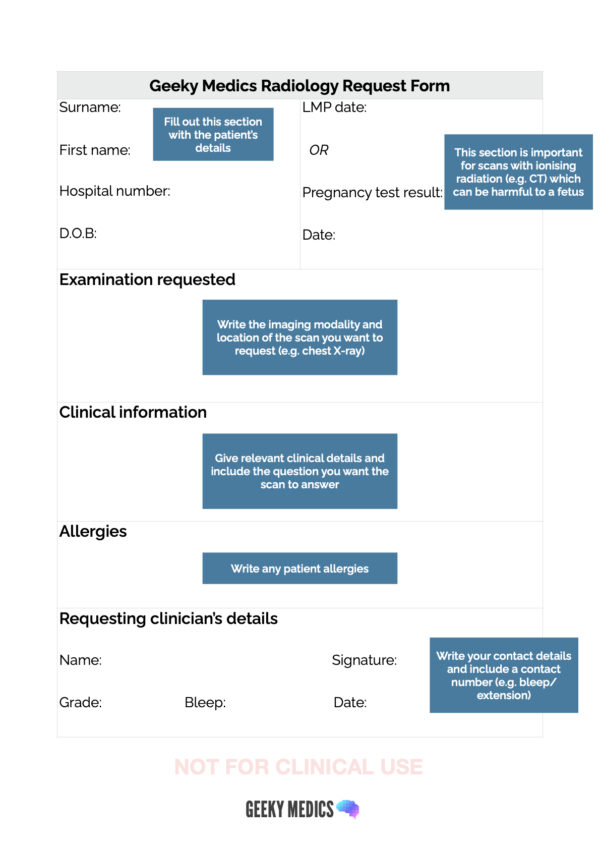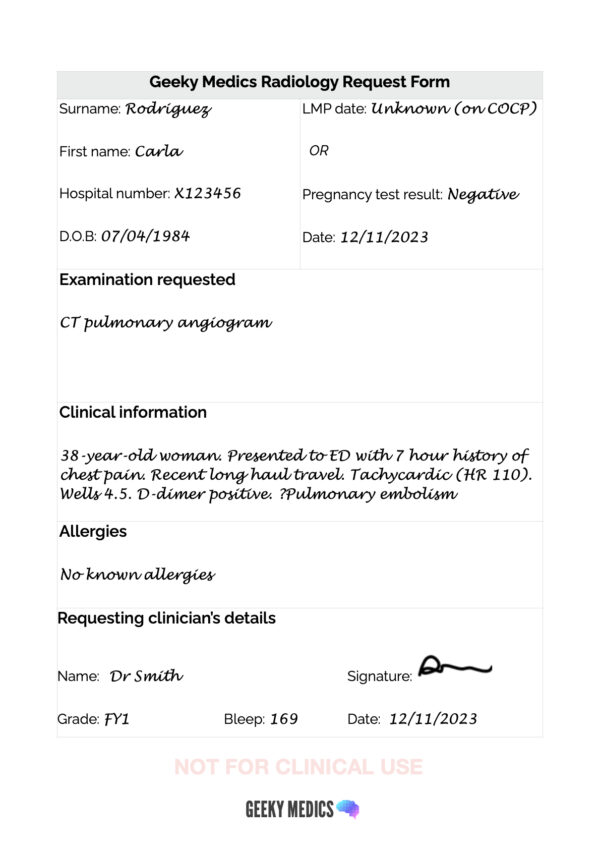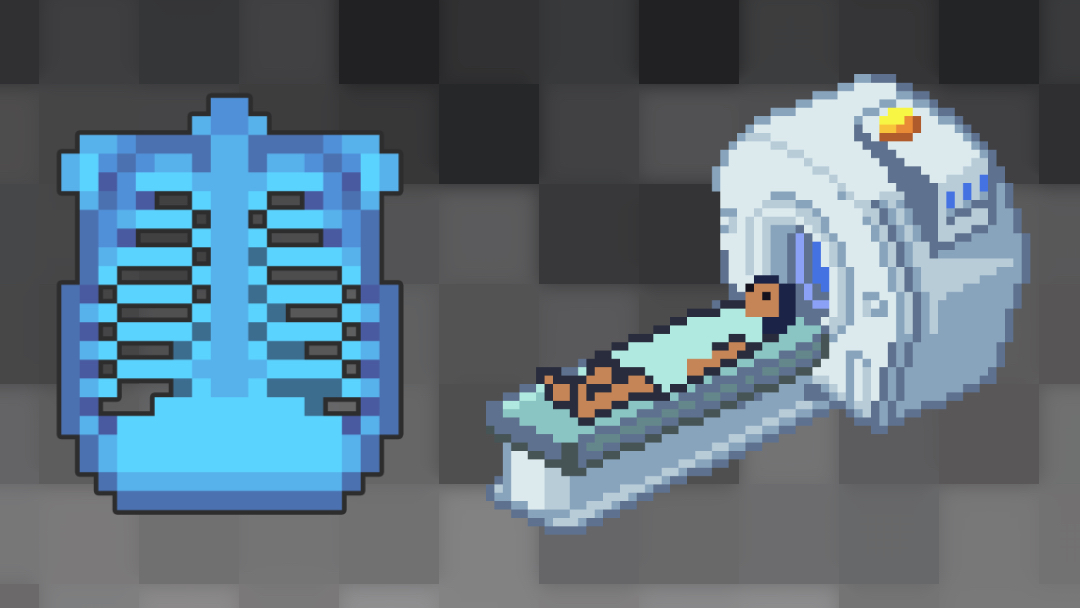- 📖 Geeky Medics OSCE Book
- ⚡ Geeky Medics Bundles
- ✨ 1300+ OSCE Stations
- ✅ OSCE Checklist PDF Booklet
- 🧠 UKMLA AKT Question Bank
- 💊 PSA Question Bank
- 💉 Clinical Skills App
- 🗂️ Flashcard Collections | OSCE, Medicine, Surgery, Anatomy
- 💬 SCA Cases for MRCGP
To be the first to know about our latest videos subscribe to our YouTube channel 🙌
Introduction
Requesting imaging (scans) is a very common task to be asked to do as a doctor, and you will likely do this daily!
Each hospital will have its own system for requesting imaging, so this guide will provide an overview of the general process of requesting a scan and what information to include in your request.
When will I need to request a scan?
It is highly likely that during a hospital rotation, you will be asked to request a scan for a patient, whether working on the wards or in the Emergency Department.
If it is appropriate and you feel confident to do so, you may decide to request a scan, and other times, a senior clinician will ask you to request a scan on their behalf.
Examples
Here are a few examples of when you may need to request a scan:
- After clerking a patient, you or your senior identifies that your patient needs a scan (e.g. a CT head for an elderly patient presenting with a fall and loss of consciousness)
- During the ward round, the consultant asks you to request a scan to help guide the patient’s treatment (e.g. an MRI head for a confused patient with unclear findings on CT)
- You are called to review an acutely unwell patient on the ward, and as part of your assessment and investigation of their deterioration, you request a scan (e.g. a chest X-ray for an elderly inpatient with a new oxygen requirement)
How do I request a scan?
The protocol for requesting imaging is likely to differ between hospitals, and even within the same hospital, you may find that the way to request a scan differs between outpatients, inpatients and the emergency department.
Most hospitals now use computer systems to request imaging; however, some departments may still use paper request forms.
When you start working at a new hospital, as part of your induction, you should be told how scans are ordered. When you first request a scan, try to ask one of your senior colleagues to go through the process with you so that you know what is required in your hospital, or try and watch a colleague order a scan during your shadowing period if you have one.
General steps
Below are the general steps you will need to take to request a scan:
- Familiarise yourself with the patient’s history and need for imaging
- Fill out the request form
- Discuss your request with the on-call radiologist
- Call the radiography department to book the scan in
- Document your conversations and the scan details
Completing the request form
Pre-reading
When requesting a scan, familiarise yourself with the patient’s history and the current clinical situation before filling out the request form.
Even if the consultant has given you the indication for the scan, you may need to discuss your request with a radiologist, and they might ask you for more detail than what the consultant has given you.
Ensure you know the patient’s presentation and a brief overview of what has happened since then. You also need to know what type of scan you are requesting (e.g. MRI, CT, X-ray), the indication for the scan, and why you want that particular imaging modality.
Additional information you may need
Depending on the type of scan you have ordered and the patient’s presentation, there are a few additional pieces of information that you may be asked to provide:
- Pregnancy status: before requesting an ionising scan (e.g. X-ray or CT) for any female of child-bearing age, you must confirm that they are not pregnant. This is because ionising radiation can be teratogenic to a fetus. If they can confirm they have had a recent period and there is no chance that they are pregnant (e.g. no recent unprotected sex or adhering to regular contraception), document this on the scan request. If they cannot confirm this, they will need a pregnancy test before having the scan. You can then document the pregnancy test result and date on the request form.
- Contrast scans: some scans used contrast to obtain results. Contrast is usually injected intravenously and is not without risk. Some patients are allergic to contrast, so it is important to clarify allergies when requesting a scan, particularly for contrast scans. Contrast can also damage the kidneys, so the patient’s renal function must be checked before giving contrast. The vetting radiologist may ask that your patient be given intravenous fluids before their contrast scan if their kidney function is poor to prevent further kidney damage.
- MRI checklist: most hospitals will ask you to complete an MRI checklist before a patient has an MRI, and it will vary between trusts whose responsibility it is to be filled out, so check with your team if this is a job for the doctors. The MRI checklist asks you to confirm that a patient is safe to have an MRI and asks in detail questions about their history, such as if they have an implanted cardiac device, metal implants, previous surgeries, allergies and previous scans. You will likely need to fill this out with your patient as it is in-depth.
Example blank request form
Below is an example of an imaging request form and a guide of what to put in each section.

Some request forms will have sections for additional information, such as the consultant’s name, ward location, and patient mobility (transport via bed, chair, walking).
Try to fill out the form in as much detail as possible, and if in doubt, ask a colleague or phone the radiography department for advice. You should also ensure that somewhere on the form, you put the clinical question you want to answer. This is the reason you are requesting the scan. For example: ?Pulmonary embolism or ?pneumonia.
Example completed request form

Booking the scan
If you have requested the scan electronically, it will likely go straight to the radiography department. If you have requested using a paper form, you will need to take the form to the department yourself.
For some scans, you can go ahead and book a scan slot for your patient with the radiography department, usually scans such as chest x-rays and ultrasounds; however, this varies between hospitals. For other scans, you must get your scan ‘vetted’ by the on-call radiology doctor.
Getting your scan vetted
Vetting allows a radiologist to read your request and decide if:
- The scan is needed at all
- You have requested the right imaging modality
- If the scan is urgent
- If any other scans are needed first
Usually, you will need to phone the on-call radiologist to get your scan vetted. They will have your request in front of them but will ask you to tell them more about the patient.
You can do this just like you would when referring a patient or discussing a patient with a senior clinician. Give a brief overview of the patient’s presenting complaint and your reasons for wanting the scan – what is the question you want to answer?
The radiologist may ask you to do other tests before accepting your request, such as a chest X-ray before a CT Pulmonary Angiogram (CTPA) for an unclear history where you want to rule out a pulmonary embolism. They may also suggest that a different type of scan is more appropriate, given the patient’s history.
The vetting radiologist may decline your request. In this case, feed this back to your senior doctor, who may provide you with more information to help with the request or speak to the radiologist themselves.
Once your scan is vetted, you can book a slot as above.
What next?
Once your scan is booked, there are a couple of tasks to consider:
- Let the ward team know when to expect the patient to go for their scan, in particular, the nurse looking after them
- Update the medical notes by documenting your conversations regarding the scan. Updating the ward or jobs list may be useful so that the other doctors know the plan.
- Book porters: some radiography departments will do this themselves, but if you are particularly keen to get an urgent scan done, it may be worth contacting porters, so that the patient physically gets to the scan.
Finally, there is no point in requesting a scan if no one will chase and action the result. Make sure you look out for the result, or hand this over to someone else to do at the end of your shift.
Key points
- Check with your hospital how scans are requested when you first start
- If a senior has asked you to request a scan on their behalf, remember to ask them for the indication, as you need to be able to justify your request when talking to the radiologist
- Make sure to include your consultant’s details if they are the one requesting the scan
- Document if you have requested a scan so that your colleagues know
- Most importantly – ask for help if you are unsure how to request the scan.




